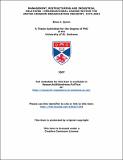Files in this item
Management, restructuring and industrial relations : organizational change within the United Kingdom broadcasting industry, 1979-2002
Item metadata
| dc.contributor.advisor | McKinlay, Alan | |
| dc.contributor.author | Quinn, Brian J. | |
| dc.coverage.spatial | vii, 247, lv p. | en |
| dc.date.accessioned | 2007-06-13T11:44:43Z | |
| dc.date.available | 2007-06-13T11:44:43Z | |
| dc.date.issued | 2007 | |
| dc.identifier.uri | https://hdl.handle.net/10023/349 | |
| dc.description.abstract | In the past decade researchers began to remedy a literature deficit in the study of broadcasting institutions – addressing in particular the issues of labour process, restructuring and industrial relations. This thesis which considers management change, industrial relations and restructuring within the United Kingdom (‘UK’) broadcasting industry employs a case study format with a view to highlighting the variations of industry (macro) and firm (micro) based restructuring. Organizational change was not a uniform process throughout the UK broadcasting industry and significantly different strategies were developed by management within the two main terrestrial broadcasters – in particular in attempting to fundamentally alter the organization of programme production. The labour process and experience of employees and owner-managers within the independent production sector was also distinguishable as between the two main UK terrestrial broadcasters. In order to provide a theoretical underpinning to the empirical studies which form the centrepiece of this thesis, the four themes of contemporary labour process theory are explored. These contributions are included because examinations undertaken of labour processes have resulted in critical insights as to the nature of management and labour relationships. Together with firm based organizational restructuring of the broadcasting industry, the past 25 years have seen very significant regulatory change consequent on a variety of legislative initiatives and which are set out. The case studies begin with the wide-scale restructuring of industrial relations within the Independent Television (‘ITV’) sector since 1979 (Chapter 4). The second case study (Chapter 5) is concerned with the implementation of a set of managerial strategies aimed at reshaping the labour processes within the Central Scotland ITV franchise – Scottish Television Ltd. (‘STV’). Chapter 6 deals with the implementation of new working practices and what might be described as an attack on employee identity within BBC Scotland. The restructuring of the Corporation along quasi-commercial lines with specific reference to the employment of the directorate (distinct business units) system is examined. The final case study (Chapter 7) is an examination of the independent production sector tracing the emergence of a group of Producer Owners (independent production company owners) who emerged during the first half of the 1990s and who have since become a significant force in British television production. This study also traces the development of the career and networking labour of the group of individuals employed on short-term contracts by the independent production company owners. | en |
| dc.format.extent | 1075506 bytes | |
| dc.format.mimetype | application/pdf | |
| dc.language.iso | en | en |
| dc.publisher | University of St Andrews | |
| dc.rights | Creative Commons Attribution-NonCommercial-NoDerivs 3.0 Unported | |
| dc.rights.uri | http://creativecommons.org/licenses/by-nc-nd/3.0/ | |
| dc.subject.lcc | HE8700.9G7Q5 | |
| dc.subject.lcsh | Television broadcasting--Great Britain | en |
| dc.subject.lcsh | Television broadcasting--Management | en |
| dc.subject.lcsh | Organizational change--Great Britain--Case studies | en |
| dc.title | Management, restructuring and industrial relations : organizational change within the United Kingdom broadcasting industry, 1979-2002 | en |
| dc.type | Thesis | en |
| dc.type.qualificationlevel | Doctoral | en |
| dc.type.qualificationname | PhD Doctor of Philosophy | en |
| dc.publisher.institution | The University of St Andrews | en |
This item appears in the following Collection(s)
Except where otherwise noted within the work, this item's licence for re-use is described as Creative Commons Attribution-NonCommercial-NoDerivs 3.0 Unported
Items in the St Andrews Research Repository are protected by copyright, with all rights reserved, unless otherwise indicated.


